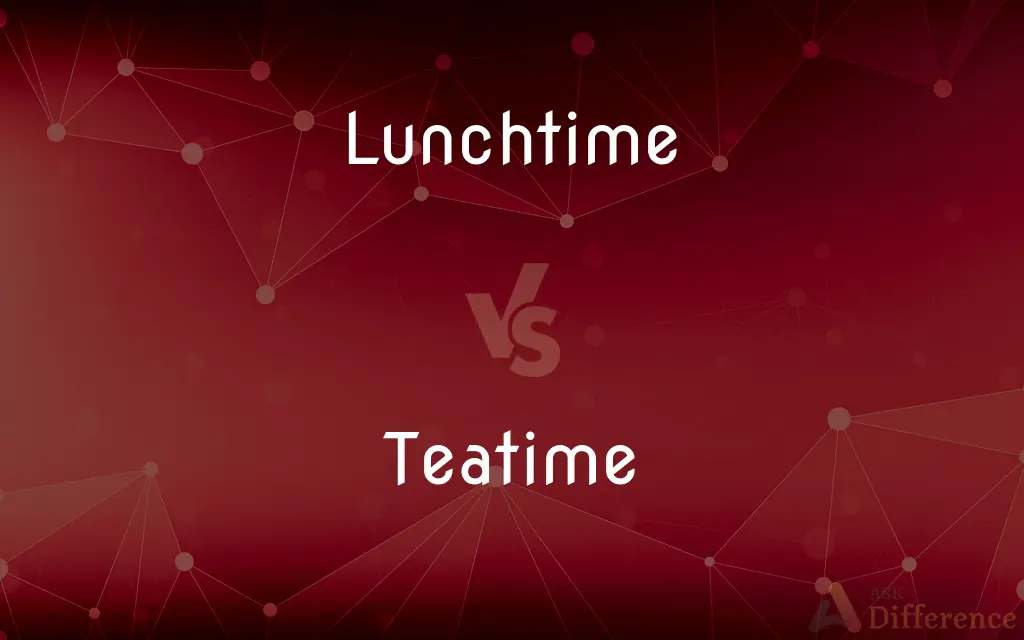Lunchtime vs. Teatime — What's the Difference?
By Tayyaba Rehman & Maham Liaqat — Updated on May 5, 2024
Lunchtime is a midday meal typically consumed between 12 PM and 2 PM, focusing on substantial food; teatime, often around 4 PM to 5 PM, traditionally involves lighter fare and tea.

Difference Between Lunchtime and Teatime
Table of Contents
ADVERTISEMENT
Key Differences
Lunchtime is generally considered the second main meal of the day, taken around midday and often consisting of a full plate of various foods like sandwiches, salads, or hot dishes. On the other hand, teatime is a lighter meal or snack in the afternoon, traditionally accompanied by tea and small items such as biscuits, cakes, or sandwiches.
In many cultures, lunchtime serves as a significant break in the work or school day, providing an opportunity to recharge with a hearty meal. Whereas teatime, particularly in British culture, is more of a social event that might include a relaxing break with tea and snacks.
The foods typically eaten at lunchtime are designed to sustain energy levels for the remainder of the day, including proteins, carbohydrates, and vegetables. Conversely, teatime often features sweets and caffeine, aimed more at enjoyment and less at nutritional fulfillment.
Lunchtime may vary somewhat by region or cultural norms but usually falls around the middle of the day. In contrast, teatime is famously set in the late afternoon, specifically around 4 PM to 5 PM, especially in the UK.
While lunchtime is recognized almost universally and accommodated in daily schedules across the world, teatime retains a particularly strong cultural significance in places like the UK, where it is embedded deeply in national tradition.
ADVERTISEMENT
Comparison Chart
Time of Day
Typically 12 PM to 2 PM
Traditionally around 4 PM to 5 PM
Primary Foods
Full meals including meats, vegetables, grains
Light snacks, often sweet, with tea
Cultural Significance
Universal, associated with a midday break
Strongly associated with British culture
Purpose
Nutritional fulfillment, energy for the day
Socializing, relaxation, enjoyment
Variability
Fixed around midday, adjusted per regional norms
More rigid, especially in traditional settings
Compare with Definitions
Lunchtime
Lunchtime refers to the period when people eat their midday meal.
At lunchtime, the cafeteria is bustling with workers.
Teatime
Traditionally important in British culture.
In England, teatime includes tea and cakes.
Lunchtime
It typically occurs midway through the workday.
We scheduled the meeting just before lunchtime.
Teatime
Teatime is a late afternoon meal associated with tea and snacks.
We invited guests for teatime on Sunday.
Lunchtime
Lunchtime is important for maintaining productivity throughout the day.
He takes his lunchtime seriously to recharge.
Teatime
It is marked by a specific hour in the afternoon.
Teatime at her house is strictly at four o'clock.
Lunchtime
The meals are usually substantial to sustain energy.
Her lunchtime meal often includes a salad and chicken.
Teatime
Teatime serves as a break for relaxation and socializing.
She enjoys teatime with her friends at the café.
Lunchtime
It varies slightly globally based on cultural norms.
In Spain, lunchtime is typically later in the afternoon.
Teatime
It often features light, sweet treats.
They served scones during teatime.
Lunchtime
The time during which lunch is usually eaten.
Teatime
The usual or traditional time for serving tea, as late afternoon.
Lunchtime
The time or hour at or around which lunch is normally eaten.
Teatime
The traditional time, in the late afternoon, for serving tea (the meal).
Lunchtime
A break in work or school to eat lunch.
It's almost lunchtime, so I think I'll finish up later this afternoon.
Teatime
A light midafternoon meal of tea and sandwiches or cakes;
An Englishman would interrupt a war to have his afternoon tea
Lunchtime
The time for eating lunch; as, he observed a regular lunchtime.
Lunchtime
The customary or habitual hour for eating lunch;
He observed a regular lunchtime
Common Curiosities
What are common foods served during teatime?
Common teatime foods include cakes, cookies, sandwiches, and scones, often accompanied by tea.
Why is teatime significant in British culture?
Teatime holds cultural significance in Britain as a traditional afternoon break for tea and snacks, reflecting historical customs.
Is there a specific etiquette associated with teatime?
In traditional settings, particularly in the UK, teatime can have specific etiquette, such as the proper way to serve tea and treats.
Is lunchtime considered important for health?
Yes, lunchtime is important for maintaining energy levels and overall health, providing a necessary break and nutritional intake.
What is a typical lunchtime duration?
Lunchtime typically lasts from about 30 minutes to an hour, allowing time to eat and relax briefly.
What typically comprises a lunchtime meal?
A typical lunch might include a variety of dishes such as sandwiches, salads, soups, or a main course with sides.
Can teatime be considered a meal?
While lighter than lunch or dinner, teatime is considered a meal focused on light snacks and beverages.
Can lunchtime vary depending on the country?
Yes, lunchtime can vary; for example, in Mediterranean countries, it might occur later in the afternoon.
How has teatime evolved in modern times?
While still rooted in tradition, modern teatime can also adapt to casual settings, with variations in the menu.
How do businesses accommodate lunchtime?
Many businesses have structured schedules that include a set break for lunch, recognizing its importance for employee well-being.
Does teatime include beverages other than tea?
Primarily, tea is the focus, but coffee or other beverages might also be offered depending on preferences.
How does lunchtime impact productivity?
A midday break for lunch can help improve concentration and productivity by giving workers time to rest and refuel.
What is the social aspect of teatime?
Teatime often serves as a social event where people gather for conversation and relaxation over tea and snacks.
What makes teatime different from a coffee break?
Teatime is usually more structured and involves light meals, while a coffee break is typically shorter and less formal.
Are there health benefits associated with having a dedicated lunchtime?
Yes, taking time for lunch helps balance blood sugar levels, supports mental health, and prevents overeating later in the day.
Share Your Discovery

Previous Comparison
Sangfroid vs. Sanguine
Next Comparison
Couches vs. DiapersAuthor Spotlight
Written by
Tayyaba RehmanTayyaba Rehman is a distinguished writer, currently serving as a primary contributor to askdifference.com. As a researcher in semantics and etymology, Tayyaba's passion for the complexity of languages and their distinctions has found a perfect home on the platform. Tayyaba delves into the intricacies of language, distinguishing between commonly confused words and phrases, thereby providing clarity for readers worldwide.
Co-written by
Maham Liaqat















































